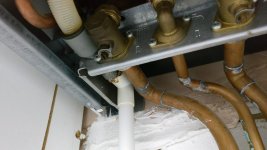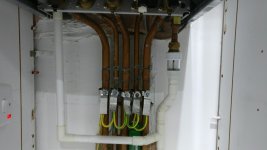Soldato
Hi boys and girls.
Had a minor drip coming out of my Worchester boiler so called out the plumbers. They 'fixed' it but it was still leaking today so had a quick nose myself. I could see that a plastic pipe that is simply slid on to a metal pipe had slipped off, so I've pushed it back on and the leak has stopped. Here's a picture:

This plastic pipe runs down and is joined by another with an odd looking clear plastic valve, then runs under the floor.

So two questions, should there be water in that pipe, and what's that clear valve thing for?
Trying to get the plumber back out without charge, as obviously I'm not a gas safe engineer!
Had a minor drip coming out of my Worchester boiler so called out the plumbers. They 'fixed' it but it was still leaking today so had a quick nose myself. I could see that a plastic pipe that is simply slid on to a metal pipe had slipped off, so I've pushed it back on and the leak has stopped. Here's a picture:

This plastic pipe runs down and is joined by another with an odd looking clear plastic valve, then runs under the floor.

So two questions, should there be water in that pipe, and what's that clear valve thing for?
Trying to get the plumber back out without charge, as obviously I'm not a gas safe engineer!

